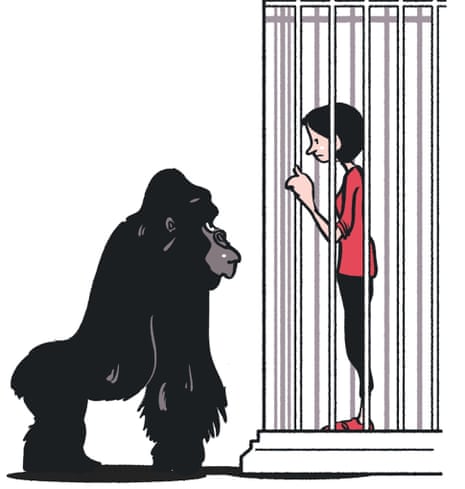It’s the first sunny Saturday of the year, and I’m in a zoo for the first time since I was a teenager, getting excited about exotic animals. Someone has tipped us off that Mrs Gorilla has had a baby, and that Mr Gorilla is getting all angry and protective of them. All the action is happening over there, so we’ve sprinted to the gorilla house, and I’m trying to get a glimpse through the reinforced glass of a hairy ape with his back to me. We humans, tiny, little, hairless idiots that we are, all have our phones ready for the moment the mighty beast finally turns round. And he does! He stares right at me and I take his picture. That face. And then I realise: it is the face of someone who could win 20 battles in a day and it wouldn’t make a damned bit of difference, because he’s already lost the war.
Then the sinking feeling in my heart: zoos haven’t changed. Oh, they will tell you that standards are amazing these days, that they spend millions recreating environments that closely model the natural ones, that strict codes of conduct are followed. And I can believe that they do spend millions, because I almost had to remortgage the house just to afford the ticket prices.
But I would like to know who wrote these codes exactly, because – and I don’t want to make a reckless stab in the dark here, but – it was humans, wasn’t it? It wasn’t a wild animal who’d escaped from one bad zoo and written down how it wanted to be treated in their next one; a trafficking victim insisting they’d quite like to do the whole thing again, only with nicer people and more carrots.
The more I walked around the place, which was doing a roaring trade, the more I felt that this was beyond weird, like some historical flashback to the days of colonial freak shows. These creatures taken from their homes and exhibited here, beneath the false skies that we’ve built for them, like some cheap Las Vegas dreamscape.
We like to pretend that we’re in awe of these huge creatures, so much bigger and stronger than us; so much more vivid, more real. But we know, really, that it’s us who are in charge. That it’s us with our technology who captured them in their jungles to swing through the trees that we planted for them.
Then we went to see a camel and I couldn’t resist taking a selfie of me and the guy with the hump – come on, it was quite funny. Well, it was until the poor creature was led out of its enclosure and its food was dropped on the ground, and everyone laughed as they watched the hungry camel scarf its rations. And then I felt sick again.
There is an argument that it’s thanks to zoos and wildlife parks that we have an interest in conservation at all, and that this is how we make sure some species don’t die out entirely, having been hunted to extinction in the wild. It’s not exactly a ringing endorsement of the human race, is it? It feels a bit like saying that you should support Ukip because they’ve really moved the racism argument on to a more sophisticated level than the BNP.
It’s not as if all the animals in the zoo are even alive. In the restaurant, there were two kinds of pizza: margherita or “meat feast”, which had various different kinds of animal all over it, slipping around on the molten cheese. I thought about it, then ordered the plain one. I’m not a vegetarian, but at that moment “meat feast” was starting to look like the saddest pair of words in the English language.
Maybe humanity is actually heading for an age of enlightenment. Perhaps one day our grandchildren will say, hang on, so as well as going to stare at monkeys in cages, people used to eat something called a shepherd’s pie? And this comfort food was made by shooting a cow in the head and then putting it through a shredder?
Leonardo da Vinci said that one day we would come to regard the mistreatment of animals as poorly as we do that of humans. I’m starting to hope he was right. As long as he didn’t say anything about taking selfies with camels.

Comments (…)
Sign in or create your Guardian account to join the discussion